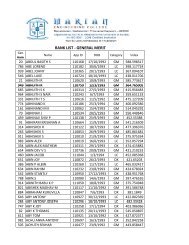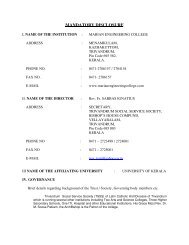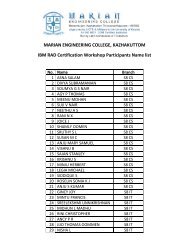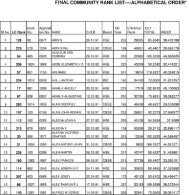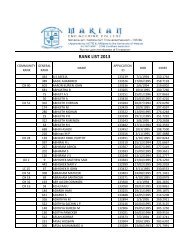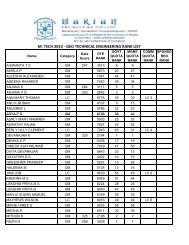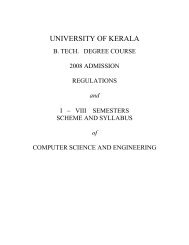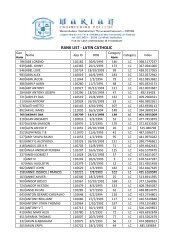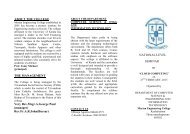UNIVERSITY OF KERALA - College of Engineering, Trivandrum
UNIVERSITY OF KERALA - College of Engineering, Trivandrum
UNIVERSITY OF KERALA - College of Engineering, Trivandrum
Create successful ePaper yourself
Turn your PDF publications into a flip-book with our unique Google optimized e-Paper software.
08. 503 STRUCTURAL ANALYSIS -II<br />
L T P/D Cr<br />
3 2 0 5<br />
Module I<br />
Concept <strong>of</strong> static indeterminacy and their determination in beams, rigid-jointed frames and pin-jointed frames -<br />
Statically indeterminate beams - Analysis <strong>of</strong> fixed beams by moment-area method – Effect <strong>of</strong> rotation and<br />
settlement <strong>of</strong> supports - Analysis <strong>of</strong> continuous beams by the theorem <strong>of</strong> three moments – Effect <strong>of</strong> settlement<br />
<strong>of</strong> supports – Introduction to force method <strong>of</strong> analysis – Method <strong>of</strong> consistent deformation and its application to<br />
indeterminate beams, rigid-jointed plane frames, pin-jointed plane frames and two-hinged arches – Effect <strong>of</strong><br />
lack <strong>of</strong> fit and temperature change in pin-jointed plane frames - Influence lines for statically indeterminate<br />
structures – Müller-Breslau principle – Influence line diagrams for various force components in propped<br />
cantilever and two span continuous beams.<br />
Module II<br />
Concept <strong>of</strong> kinematic indeterminacy and their determination in beams, rigid-jointed frames and pin-jointed<br />
frames - Kinematically indeterminate beams – Introduction to displacement method <strong>of</strong> analysis – Slopedeflection<br />
method for beams and rigid jointed plane frames (with and without sway) including frames with<br />
sloping legs – Effect <strong>of</strong> settlement <strong>of</strong> supports – Moment Distribution method for beams and rigid jointed plane<br />
frames (with and without sway) – Effect <strong>of</strong> support settlement – Kani’s method for beams and rigid jointed<br />
plane frames <strong>of</strong> different geometry (with and without sway) – Introduction to approximate methods <strong>of</strong> analysis<br />
for multistoreyed frames - Substitute frame method – Cantilever method – Portal method (No numerical<br />
examples in approximate methods)<br />
Module III<br />
Introduction to Structural Dynamics – Dynamic systems and loads – D’Alembert’s principle – Systems with<br />
single degree <strong>of</strong> freedom – Equation <strong>of</strong> motion - Free vibration and forced vibration – Undamped and damped<br />
free vibration – Logarithmic decrement – Response <strong>of</strong> single degree <strong>of</strong> freedom systems subjected to harmonic<br />
loading – Single degree <strong>of</strong> freedom systems subjected to support motion such as earthquake ground motion –<br />
formulation <strong>of</strong> equation <strong>of</strong> motion.<br />
References:<br />
1. Junarkar S. B. and Shah S. J., Mechanics <strong>of</strong> Structures, Vol. II, Charotar Publishing House Pvt. Ltd.,<br />
New Delhi<br />
2. Devdas Menon, Structural Analysis, Narosa Publishing House, New Delhi.<br />
3. Reddy C. S., Basic Structural Analysis, Tata McGraw Hill, New Delhi.<br />
4. Anand A. S., Theory <strong>of</strong> Structures, Indeterminate Structural Analysis, Sathyaprakasan, NewDelhi.<br />
5. Wang C. K., Indeterminate Structural Analysis, Tata McGraw Hill, New Delhi.<br />
6. Norris, C. H. and Wilbur J. B., Elementary Structural Analysis, McGraw Hill, New York.<br />
7. Hibbeler R. C., Structural Analysis, Pearson Education, New Delhi.<br />
8. Ghali A., Neville A. M. And Brown T. G., Structural Analysis – A unified classical and matrix<br />
approach, Spon Press, London and Newyork.<br />
9. Mario Paz, Structural Dynamics – Theory and Computation , CBC Publishers and distributors, New<br />
Delhi<br />
10. Clough R W. and Penzien J. Dynamics <strong>of</strong> Structures, Mc-Graw Hill, Newyork<br />
11. Anil K.Chopra, Structural Dynamics- Theory and Applications to Earthquake <strong>Engineering</strong>, Pearson.<br />
Question paper: Duration : 3 hours<br />
The question paper consists <strong>of</strong> Part A and Part B.<br />
Part A is for 40 marks. There will be 8 compulsory short answer questions <strong>of</strong> 5 marks each covering the entire<br />
syllabus.<br />
Part B is for 60 marks. There will be two questions from each module. The candidate has to answer one<br />
question <strong>of</strong> 20 marks from each module.<br />
Note: No charts, tables, codes are permitted in the Examination hall .If necessary relevant data shall be given<br />
along with the question paper by the question paper setter.<br />
45



